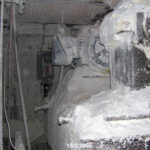Combustible Dust Safety Talk Handout

BENEFITS
If a so-called ‘combustible dust,’ such as dust from wood, coal, rubber, grain, sugar, flour, cardboard and aluminum, is suspended in air at a high enough concentration, a source of ignition such as a spark, static, an open flame or a hot surface can trigger a fire or explosion. Thus, combustible dust poses a serious safety hazard. For example, coal dust was one of the causes of the Westray mine explosions. And in 2008, a huge explosion and fire at a sugar refinery in Georgia killed 14 and seriously injured 38. That explosion was fueled by massive accumulations of combustible sugar dust throughout the packaging building. As a result, Canadian OHS laws require employers to take steps to address the hazards posed by combustible dust.
HOW TO USE THE TOOL
If combustible dust is a safety hazard in your workplace, adapt this handout for the requirements in the OHS laws in your jurisdiction as to combustible dust and the right to refuse unsafe work, and for your operations and equipment. Give the handout to workers in conjunction with a safety talk on combustible dust.